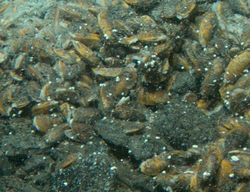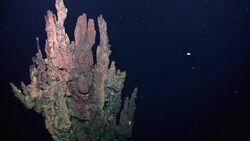Biology:Bathymodiolus thermophilus
| Bathymodiolus thermophilus | |
|---|---|

| |
| Scientific classification | |
| Domain: | Eukaryota |
| Kingdom: | Animalia |
| Phylum: | Mollusca |
| Class: | Bivalvia |
| Order: | Mytilida |
| Family: | Mytilidae |
| Genus: | Bathymodiolus |
| Species: | B. thermophilus
|
| Binomial name | |
| Bathymodiolus thermophilus | |
Bathymodiolus thermophilus is a species of large, deep water mussel, a marine bivalve mollusc in the family Mytilidae, the true mussels. The species was discovered at abyssal depths when submersible vehicles such as DSV Alvin began exploring the deep ocean.[3] It occurs on the sea bed, often in great numbers, close to hydrothermal vents where hot, sulphur-rich water wells up through the floor of the Pacific Ocean.
Description
Bathymodiolus thermophilus is a very large mussel with a dark brown periostracum, growing to a length of about 20 cm (8 in). It is attached to rocks on the seabed by byssus threads but it is able to detach itself and move to a different location. It is sometimes very abundant, having been recorded at densities of up to 300 individuals per square metre (270 per square yard).[4]
Distribution
Bathymodiolus thermophilus is found clustered around deep sea thermal vents on the East Pacific Rise between 13°N and 22°S and in the nearby Galapagos Rift at depths around 2800 metres (one and a half miles).[4][5]
Deep sea hydrothermal vents are frequently found along tectonic plate boundaries, and underwater mountain ranges and ridges. They are particularly well dispersed along the global mid-ocean ridge system.[6] Specific geographical barriers exist along the mid-ocean ridge system that may impede gene flow between populations along the ridge-axis.[6] A study sampled mussels across various topographical interruptions along the ridge system and localities encompassed the Galapagos Rift and the East Pacific Rise. Results determined that mussel populations that were geographically isolated from one another via the Easter Microplate, known for its strong cross-axis currents, were genetically more divergent than populations from the Galapagos Rift and the East Pacific Rise, where there are no barriers to dispersal and no isolation-by-distance.[6] Mussels in these populations were genetically homogeneous and contained high levels of unimpeded interpopulational gene flow.[6]
The environments surrounding hydrothermal vents are important for the B. thermophilus to survive. It has been shown that environmental changes can impair the ability of the mussels and their symbiotic bacteria to live.[7] Research has shown that when the B. thermophilus are experimentally placed in a low-sulfide environment, the gill symbionts are lost, and the mussels suffer harm to the gills and body conditions.[7]
The distribution of B. thermophilus along hydrothermal events has an impact on the biodiversity in the environment. High-density mussel populations can directly inhibit the recruitment of invertebrates at deep-sea hydrothermal vents.[8] When researchers transplanted B. thermophilus to a naturally high density hydrothermal vent, there was a lower recruitment at the hydrothermal vent in just 11 months.[8] A potential reason for this phenomenon is due to enhanced predation or avoidance of superior competitors.[8]
Symbiosis and feeding
Bathymodiolus thermophilus feeds by extracting suspended food particles from the surrounding water through its gills. This mostly consists of the bacteria that live around the vent, often forming a dense mat. As a result, B. thermophilus possesses a chemosymbiotic relationship with a Gammaproteobacteria that oxidizes hydrogen sulfide in the mussel's gills.[9] The mussel absorbs nutrients synthesized by bacteria and is not reliant on photosynthetically produced organic matter. The bacteria lacks enzymes used to synthesize succinate and tricarboxylic acid cycle intermediates, but is able to synthesize nutrients by using sulfur compounds in the environment.[9] The genome of the bacteria reveals that it possesses pathways for the sulfide energy source and encodes cycles for CO
2 fixation.[9] Only mussels that contain high concentrations of bacteria demonstrated the ability to perform CO
2 fixation.[10] The bacteria also contain genes for cell surface adhesion, bacteriotoxicity, and phage immunity. These genetic characteristics may help the chemosynthetic bacteria defend against the B. thermophilus’ immune system, which allows for the bacteria to live in the mussels’ gills without being killed.[9]
Not only does the chemosymbiotic relationship between B. thermophilus and the bacteria benefit the mussel, but there is some speculation that living inside the gills of the mussel also benefits the bacteria. It is possible that living within another host helps the bacteria withstand the harsh environment of the hydrothermal vents.[10]
Life cycle
The larvae of Bathymodiolus thermophilus drift with the currents and are planktotrophic, feeding on phytoplankton and small zooplankton. This method of feeding is likely to give them good dispersal capabilities and it has been shown by DNA analysis that there is a high rate of gene flow between populations round different vents.
The Bathymodiolus species represents one of the most well-known fauna to colonize hydrothermal vents and cold seeps.[11] In particular, B. thermophilus has been extensively studied due to their chemosynthetic symbioses and their crucial roles in ecosystem productivity. In early stages of development, deep-sea mussels appear to follow similar growth processes of gametogenesis in comparison to shallow-water mytilidae. It has been observed that Bathymodiolins produce small oocytes which may predict high fecundity levels for this species.[11] While there are limited studies regarding fecundity of B. thermophilus, one way to improve understanding of both fecundity as well as spawning patterns would to observe a spawning event with use of yearly sampling.[11]
Adult stages of the bathymodioline species have received the most attention, especially when studying the bacterial symbionts that are fundamental to the mussels nutritional needs.[11] When reaching maturity, adults form close aggregations along seeps and vents.[11]
The mantle of B. thermophilus serves two physiological roles, one being the accumulation of somatic reserves, and the other being the development of the gonads.[11] Gonads likely originate from germinal stem cells that appear in germinal stem-cell clumps around the dorsal region, between the mantle and the gill of the animal. In larger adult specimens, gonads can extend along the mantle epithelium.[11] Gametogenesis occurs in small saclike cavity in a matrix of connective tissue supplied with seminal cells. In males, sertoli cells deliver nutrients to the developing gametes, where follicle cells perform the analogous role in female mussels.[11]
Evolution and phylogeny
Analysis of DNA sequence data posited that mussels of subfamily Bathymodiolinae were divided into four groups. B. thermophilus belongs to Group 2, along with four other species: B. septemdierum, B. brevior, and B. marisindicus.[12] All members of Group 2 subspecies were labelled as thioautotrophs, chemoautotrophic organisms that feed on sulfides. Sequence data provided evidence for an outgroup of Modioline species from sunken wood and whale carcasses and that the phylogeny of Bathymodiolus mussels and their relatives had derivations from a single ancestor with COI (cytochrome C oxidase subunit I) or ND4 (NADH dehydrogenase subunit 4) sequence data.[12]
References
- ↑ "A new mussel (Bivalvia: Mytilidae) from hydrothermal vents in the Galapagos Rift zone.". Malacologia 26 (1–2): 253–271. 1985.
- ↑ "Bathymodiolus thermophilus Kenk & Wilson, 1985". WoRMS. World Register of Marine Species. 2010. http://www.marinespecies.org/aphia.php?p=taxdetails&id=183000.
- ↑ "Microhabitat variation in the hydrothermal vent mussel, Bathymodiolus thermophilus, at the Rose Garden vent on the Galapagos Rift" (in en). Deep Sea Research Part A. Oceanographic Research Papers 35 (10): 1769–1791. October 1988. doi:10.1016/0198-0149(88)90049-0. ISSN 0198-0149. Bibcode: 1988DSRA...35.1769F.
- ↑ 4.0 4.1 "Hydrothermal vents". Deep Ocean, Fathom Archive. Columbia University. http://www.fathom.com/course/10701050/session6.html.
- ↑ Deep-Sea Vent Mussels Monterey Bay Aquarium Research Institute. Retrieved 2012-04-15.
- ↑ 6.0 6.1 6.2 6.3 "Dispersal barriers and isolation among deep-sea mussel populations (Mytilidae: Bathymodiolus) from eastern Pacific hydrothermal vents". Molecular Ecology 12 (1): 169–184. January 2003. doi:10.1046/j.1365-294x.2003.01726.x. PMID 12492886.
- ↑ 7.0 7.1 "Tissue and symbiont condition of mussels (Bathymodiolus thermophilus) exposed to varying levels of hydrothermal activity" (in en). Journal of the Marine Biological Association of the UK 84 (1): 229–234. February 2004. doi:10.1017/S0025315404009087h. ISSN 0025-3154.
- ↑ 8.0 8.1 8.2 "Biotic interactions at hydrothermal vents: Recruitment inhibition by the mussel Bathymodiolus thermophilus" (in en). Deep Sea Research Part I: Oceanographic Research Papers 55 (12): 1707–1717. December 2008. doi:10.1016/j.dsr.2008.07.007. Bibcode: 2008DSRI...55.1707L.
- ↑ 9.0 9.1 9.2 9.3 "Genome sequence of the sulfur-oxidizing Bathymodiolus thermophilus gill endosymbiont". Standards in Genomic Sciences 12 (1): 50. December 2017. doi:10.1186/s40793-017-0266-y. PMID 28878861.
- ↑ 10.0 10.1 "Evidence of in situ uptake and incorporation of bicarbonate and amino acids by a hydrothermal vent mussel" (in en). Journal of Experimental Marine Biology and Ecology 96 (2): 191–198. April 1986. doi:10.1016/0022-0981(86)90242-X.
- ↑ 11.0 11.1 11.2 11.3 11.4 11.5 11.6 11.7 "Lifecycle Ecology of Deep-Sea Chemosymbiotic Mussels: A Review". Frontiers in Marine Science 5. August 2018. doi:10.3389/fmars.2018.00282. ISSN 2296-7745.
- ↑ 12.0 12.1 "Evolutionary process of deep-sea bathymodiolus mussels". PLOS ONE 5 (4): e10363. April 2010. doi:10.1371/journal.pone.0010363. PMID 20436906. Bibcode: 2010PLoSO...510363M.
Wikidata ☰ Q4869188 entry
 |


